
As the counterspace inside our kitchens continues to dwindle, appliance manufacturers turn to marketing their devices as multi-functional, do-it-all solutions that cover a wide range of cooking methods. Toaster ovens and air fryers are prime examples: they both promise performance in baking, roasting, dehydrating, and air frying; blur the line between the two products and their intended uses; and create confusion for shoppers. Here at RTINGS.com, we've already reviewed both air fryers and toasters, both of which many toaster ovens claim to replace. For an in-depth look at air fryer design and performance, check out this article, and for toaster design and performance, check out this article.

The debate of 'Air Fryers versus Toaster Ovens' remains popular in online communities, but little information is available about what distinguishes the products and how they excel in different areas.


Despite their advertised features, the two products are fundamentally different in design, which makes them suitable for different purposes. Our testing revealed that while toaster ovens offer more versatility, many of them offer subpar performance when air frying (although a few of them surprised us!). If air frying remains your top priority for a countertop appliance, most conventional, basket-style air fryers will offer better performance.

Toaster Ovens Versus Air Fryers: Key Design Differences
The term "air fry" has evolved into a marketing buzzword, with manufacturers slapping the label on full-size ovens, toaster ovens, and even microwaves. Indeed, it seems you can add a small fan to any appliance today and call it an air fryer.

This raises the question of whether a dedicated air fryer still has a purpose in your kitchen when many other modern appliances claim to offer the capability.

The principle of air frying is simple: hot air circulates around the cooking chamber, transferring heat by convection and removing moisture from the surface of the food, thereby producing a crispy result. By definition, any chamber with a heater and a fan could be considered an air fryer. However, conventional, basket-style air fryers incorporate several design choices to optimize this process and improve performance.
Air Fryers are not just Convection Ovens
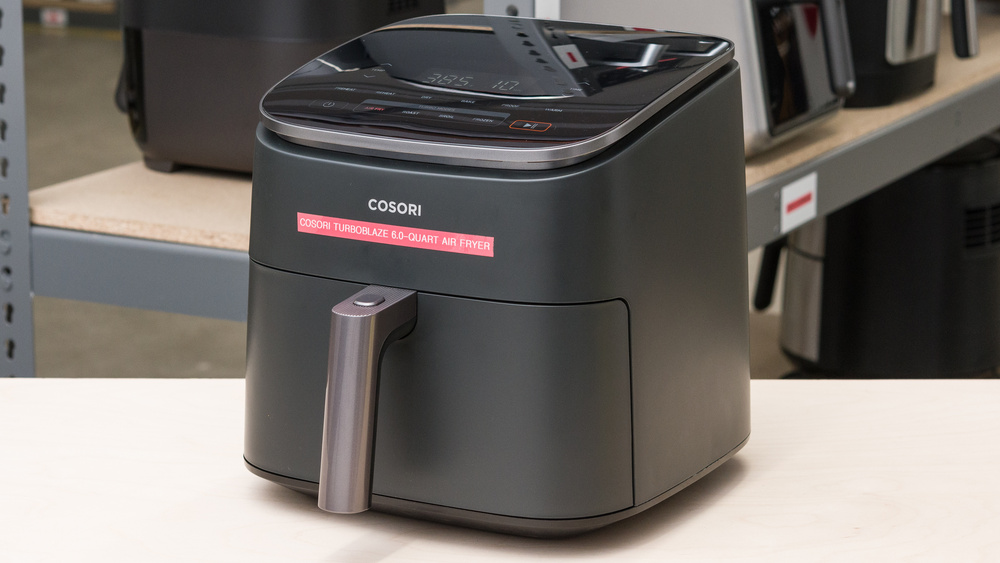
When researching between the two types of products, many will be quick to explain an air fryer is nothing more than a small convection oven.



While this definition isn't technically incorrect, it oversimplifies how an air fryer really works and overlooks the combination of design elements that make it so effective—especially when compared to a traditional convection oven. A convection oven is basically a regular oven with the addition of a fan to circulate the air inside the cooking chamber. The air circulation serves to even out temperature gradients inside the oven and promote forced convection. This lack of focus on an air fryer's design adds to the confusion and further complicates the process of choosing between the two types of products.
The fundamental design of a basket-style air fryer is not complex; rather, it is the geometry and layout of components that optimize heat transfer and airflow, creating a system capable of quickly cooking and removing moisture from food. There are eight main components:
- Outer housing
- Cooking chamber, typically a removable basket
- Cooking tray, perforated to allow air circulation beneath the food
- Spiral-shaped, tubular resistive heating element (commonly known as a Calrod™ heater)
- Fan coupled to an electric motor
- Electronic or mechanical controls
- Temperature sensor
- Rear vent

The heating element, positioned directly above the food, typically draws between 800 to 1800 watts of power. Above the heater is the fan, which operates at speeds ranging from 2500 to 3600 RPM and draws 20 to 50 watts of power. As the fan blows the air, it immediately passes through the heating element, so the air is already heated as it enters the cooking chamber before flowing downward and toward the food. When you consider the relatively small size of the cooking chamber (2 – 8 quarts), air fryers combine intense, localized heat and strong airflow in a compact space. This design maximizes convective heat transfer and rapid removal of moisture from the food. The large vent in the rear then expels this moisture-laden air creating an ideal environment for quickly crisping food.
Toaster Ovens are Small Convection Ovens
Toaster ovens, in their most basic form, are small, countertop ovens that primarily use infrared energy to quickly brown the surface of food, hence the name "toaster" oven. They can range in size from tiny, desk-sized units that can accommodate a single slice of bread, to near microwave-sized units capable of fitting multiple baking sheets and small chickens.

The addition of digital temperature control and convection fans have improved their capabilities for tasks like baking, roasting, and air frying. However, adding a fan and an air fry function to a toaster oven doesn't mean it offers good air frying performance. In fact, before air frying was a widely recognized technology, many toaster ovens already had fans, improving their performance in convection baking and roasting. As air frying became more popular, "air frying" buttons on toaster ovens also became more prominent.
Most toaster ovens are similar in design and consist of the following main components:
- Outer housing
- Inner cooking chamber
- Glass door
- Upper and lower straight tube heating elements (from 2 to 6, typically)
- Electronic or mechanical controls
- Temperature sensor
- Fan coupled to an electric motor (in some models)
You'll notice that the parts list of a toaster oven is very similar to that of an air fryer. However, how the components are laid out and function inside the toaster oven offers distinct advantages for certain cooking methods, but it also makes a toaster oven less effective for air frying, specifically.

A toaster oven operates in many ways like a conventional, full-size oven just at a smaller scale. The role of the upper and lower heating elements in a toaster oven is to produce radiant heat for cooking the top and bottom of foods simultaneously. The temperature sensor maintains the internal temperature by switching the elements on and off. The fan (if present) is most commonly located on the side of the cooking chamber, away from the heating elements. This design choice serves to even out the temperature gradients inside the toaster oven. However, it doesn't produce the same rapid heating effect as an air fryer, as the air isn't directed through the heating element.
There are two commonly used types of heating elements in toaster ovens: quartz and Calrod™ (a metal sheathed heater), which both have their advantages. In short, quartz elements cook primarily via infrared radiation, making them excellent for quickly browning foods. Calrod™ heaters cook primarily via convection and have a slower but more stable transfer of heat, making them ideal for processes like baking (this type of heater is commonly found in full-size ovens). For an in-depth explanation of these heating elements, check out our article comparing toaster ovens to full-size ovens.
The final thing to note about a toaster oven's intended purpose is that they come with a variety of accessories for different cooking methods. They will always come with a wire rack for toasting bread and a baking sheet. However, if you're looking for a toaster oven with any chance of being a good air fryer, it's critical that it comes with an included mesh air frying basket:
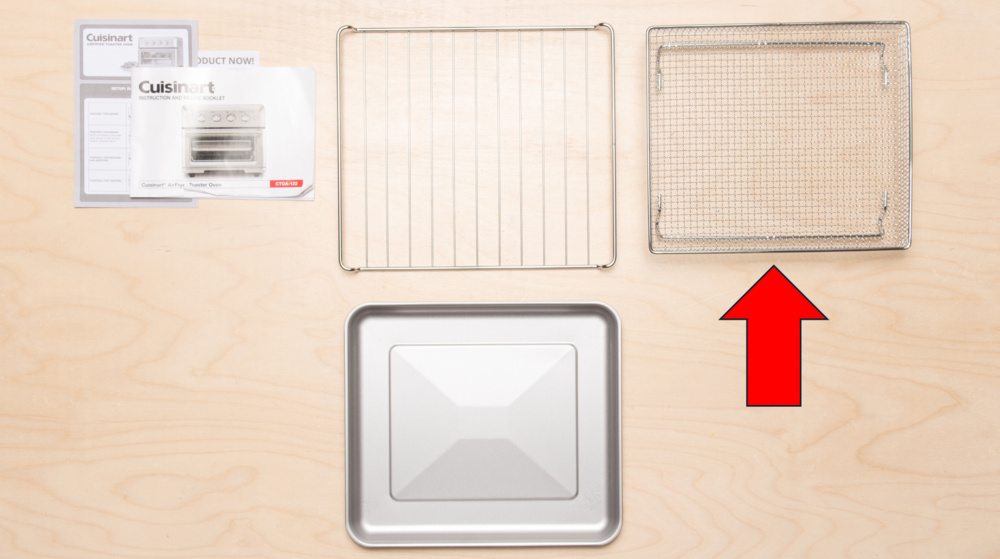
When air frying, the mesh basket ensures the food is properly exposed to the airflow and that air can circulate around and beneath the food. This serves the same purpose as the perforated cooking tray in a basket-style air fryer.
How The Air Fryer Function On Toaster Ovens Performs Compared To Air Fryers
With a good understanding of how the two appliances differ in design, we can better explain the results and answer the question that many users have: are toaster oven "air fryers" good at air frying?
There are mixed responses to this question online, with many users' experiences aligning with what we found during our testing:




Conversely, some users report being satisfied with their toaster oven's air frying performance:
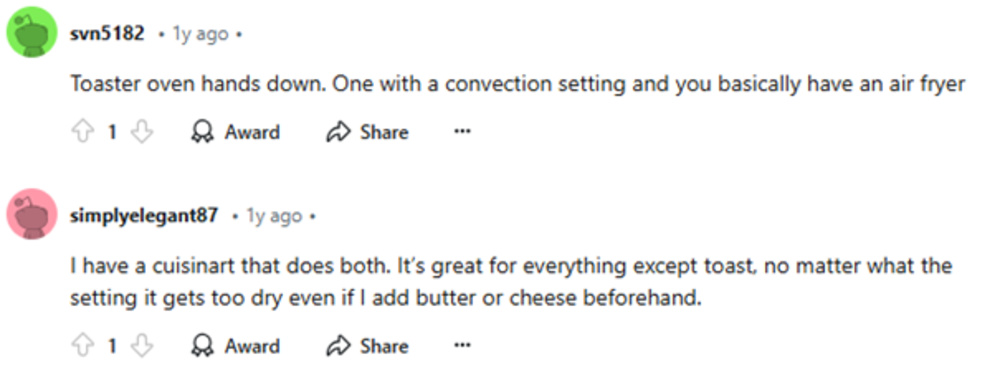

With mixed opinions online, one of our users even suggested that we specifically test the air frying performance of toaster ovens:
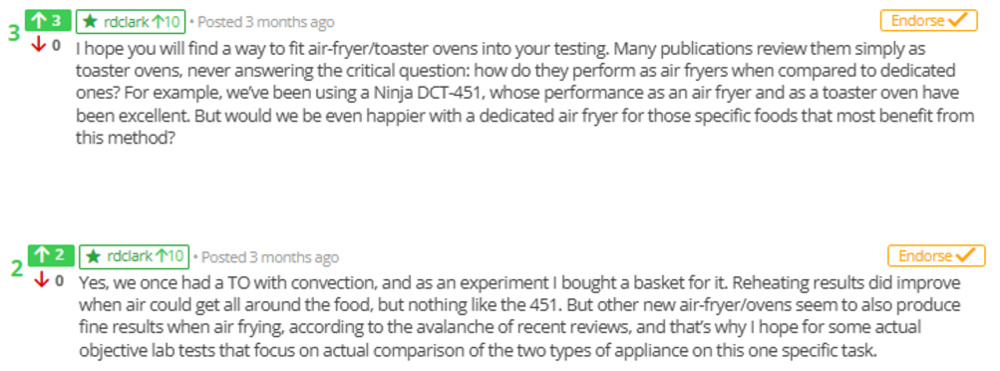
So, we made it one of our goals to clear up the confusion surrounding these two products and answer the question.
Adapting our Air Frying Methodology
For air fryers, we developed an objective test to measure their cooking speed based on the rate at which the food lost moisture. This test involved placing the air fryer on a digital scale to track the time it took to reach a specific target—in this case, a 45% weight loss for our test food: French fries. All tests were conducted at a consistent temperature of 400 °F. Once this target was reached, we evaluated each fry by hand to assess how crispy and evenly cooked the entire batch was. For an example of our evaluation process, see this video.
Adapting this method to toaster ovens was simple: we bought a larger-scale platform to accommodate their larger size.

Only 11 of the 20 toaster ovens we tested included a dedicated air fry setting. For those with fans but no air fry mode, we used the convection bake setting at 400 °F. For those that lacked a fan entirely, we simply baked at the same temperature. If the toaster oven didn't include a mesh air frying basket, we used the included baking pan. By keeping the same test methodology, we can directly compare the results between toaster ovens and air fryers.
The Results: Basket-Style Air Fryers offer Crispier and Faster Air Frying than most Toaster Ovens
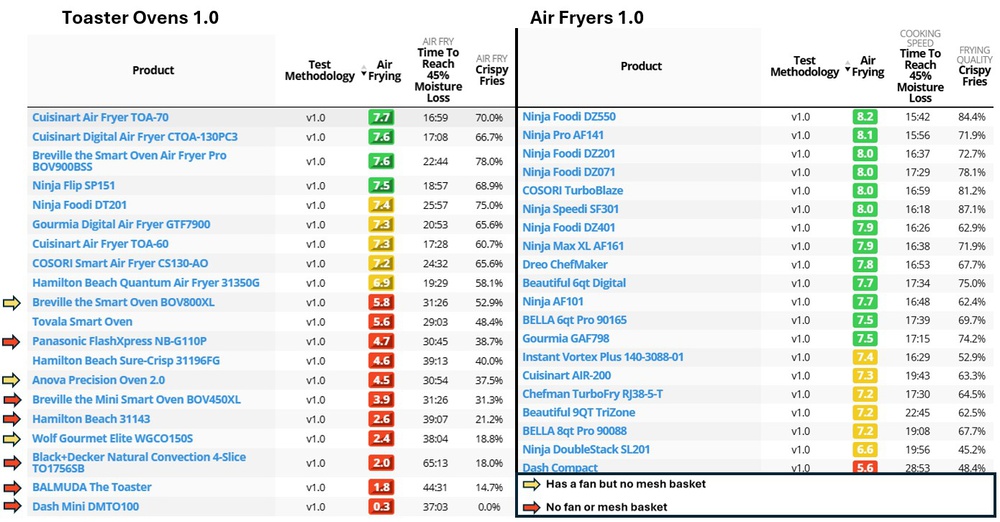
Looking at the table, one thing is obvious: there are mixed results on the toaster oven side and a lot of green on the air fryer side. If we break it down into the types listed in the table, we can see performance differences between air fryers and different types of toaster ovens.

The toaster ovens that include a fan for settings like convection baking but do not include a mesh basket are not ideal for air frying.
| Toaster Oven Air Frying Performance (with fan but no mesh basket n=3) | |||
| Metric | Minimum | Median | Maximum |
| Time To Reach 45% Moisture Loss (hh:mm:ss) | 00:30:54 | 00:31:26 | 00:38:04 |
| Crispy Fries (%) | 18.8 | 37.5 | 52.9 |
They all require above 30 minutes to remove the target amount of moisture from the food. Consequently, by the time they reach their target moisture loss, the fries are still not crispy and instead have a mushy texture. The Wolf Gourmet Elite WGCO150S had the worst result, as shown in this evaluation video. This highlights the importance of high airflow for proper air frying, and the results can be extrapolated for other cooking methods like roasting where a crispy texture is desired.
If we review the results for toaster ovens that have neither a fan nor mesh basket, it gets even worse:
| Toaster Oven Air Frying Performance (no fan or mesh basket n=6) | |||
| Metric | Minimum | Median | Maximum |
| Time To Reach 45% Moisture Loss (hh:mm:ss) | 00:30:45 | 00:38:05 | 01:05:13 |
| Crispy Fries (%) | 18.8 | 20.6 | 38.7 |
With a median time of 38 minutes to cook French fries, and up to over an hour as the worst result, these types of toaster ovens are not suitable for air frying or any kind of cooking requiring forced convection. The link between cooking time and food texture is even more profound here, with a median of just 20.6% of the fries being crispy and, at worst, an unacceptable 0%. To the credit of these toaster ovens, however, they do not market themselves as air fryers.
While it's useful information to have, most users looking for a toaster oven with air frying capabilities will likely research those marketed as such. If we narrow down the table to those having a dedicated air fry setting, fan, and mesh basket, although the sample size is smaller, the results look a lot better.
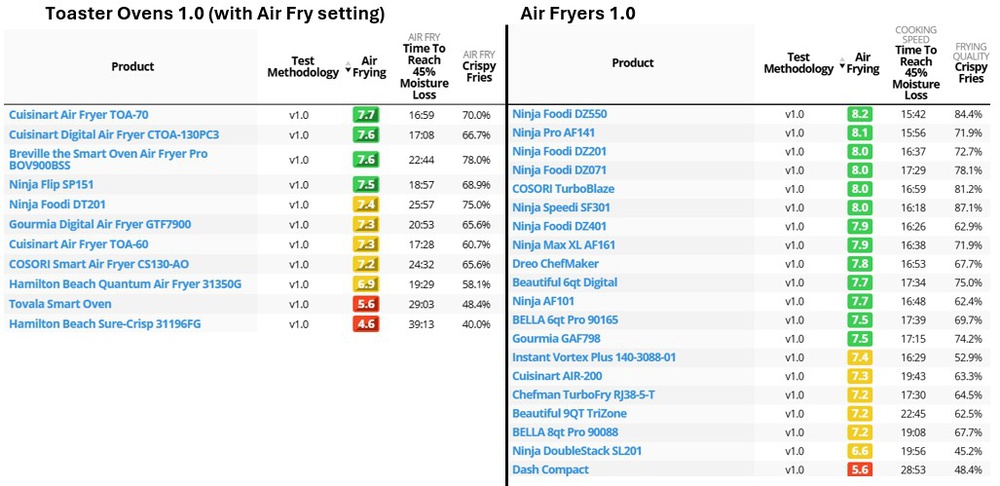
| Air Fryer Toaster Ovens versus Basket-Style Air Fryers | ||||
| Product Type | Metric | Minimum | Median | Maximum |
| Air Fryer Toaster Ovens | Time To Reach 45% Moisture Loss (hh:mm:ss) | 00:16:59 | 00:20:53 | 00:39:13 |
| Crispy Fries (%) | 40.0 | 65.6 | 78.0 | |
| Basket-Style Air Fryers | Time To Reach 45% Moisture Loss (hh:mm:ss) | 00:15:42 | 00:17:07 | 00:28:53 |
| Crispy Fries (%) | 45.2 | 68.7 | 87.1 | |
The majority of toaster ovens touted as air fryers offer decent performance, and there are even a couple that outperform some middle-ranked, basket-style air fryers we've tested. That said, the median time to reach 45% moisture loss is 3 minutes and 46 seconds shorter for basket-style air fryers (17:07 vs. 20:53). Basket air fryers also achieve higher percentages of crispy fries on average (68.7% vs. 65.6%). More importantly, the performance range for basket air fryers is narrower, whereas air fryer toaster ovens show a greater variability between models. While a few air fryer toaster ovens come close, the majority will fall behind in both speed and crisping performance.
What Makes a Toaster Oven Good for Air Frying
If you're after the best air frying performance in a toaster oven, there are key design choices to look for. Most air fryer toaster ovens, despite having mesh baskets, lag behind basket-style air fryers primarily due to the placement of their fan. As covered in the design section, basket-style air fryers position their fans directly above the heaters, allowing the air to rapidly heat before being directed towards the food. In contrast, most air fryer toaster ovens (and convection ovens in general) use side-mounted fans positioned away from the heating elements. This fan placement simply circulates air inside the chamber, instead of forcing air through the heater to rapidly gain energy before it reaches the food.
Among the best toaster ovens we've tested for air frying performance, the Cuisinart Air Fryer TOA-70 and the Ninja Foodi DT201, rank among the top for producing crispy fries, achieving some of the highest percentages in our tests thanks to design features that closely mimic basket-style air fryers.

The Cuisinart model achieves this by positioning its fan above the food and the top heaters.
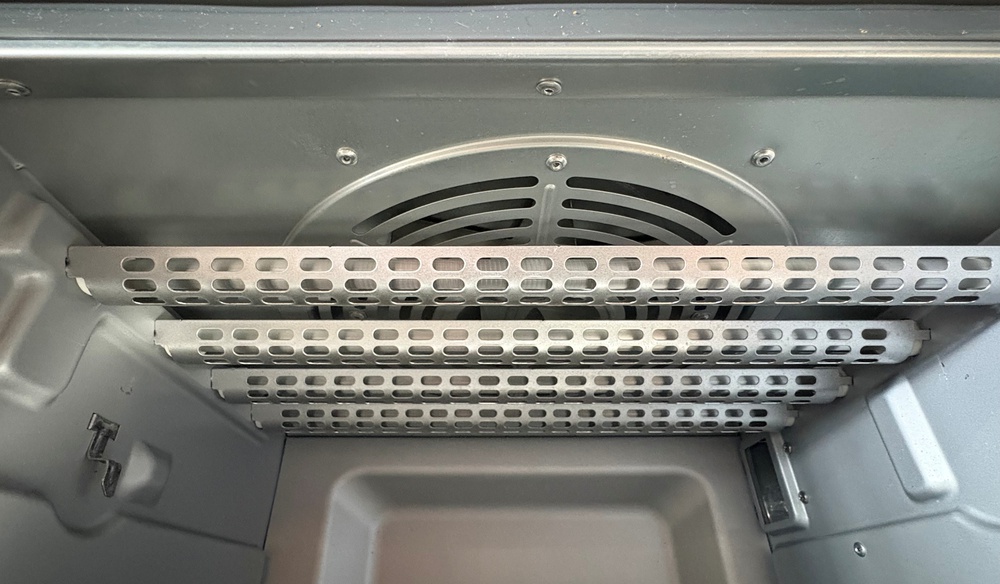
When set to the air fry setting, only the top four heating elements are activated, delivering a combined output of 1600 watts. This design closely mirrors a basket-style air fryer, as it forces air directly through high-wattage heaters before directing it toward the food.
The Ninja Foodi DT201 achieves a similar effect, albeit in a different way. Instead of using the quartz elements as the heat source, it has a dedicated heater in the rear, positioned directly next to the fan.

Similarly, this is the only heater that's switched on when using the air fry setting, allowing the full 1600 watts to be dedicated to heating the air as it passes through the fan. While some air fryers simply rebrand their convection label as air frying, as we've seen, these two toaster ovens actually change how they behave when this mode is activated to try and air fry more effectively.
What Toaster Ovens Lack In Air Frying Performance, They Make Up For In Versatility


While the compact package of intense heat and airflow make basket-style air fryers excellent in the task they were designed for, it also limits the number of cooking methods they can reasonably achieve. The comparatively small internal volume and cooking surface area make it challenging to cook anything you wouldn't normally place in a basket and shake while cooking. Furthermore, while some air fryers can limit their fan speed as low as 1000 RPM, none of them are able to disable the fan completely (this is because the fan also plays an important role in cooling the air fryer's housing during operation). The constant airflow means that air fryers are always cooking with forced convection.
Conversely, toaster ovens do not require fans to operate. Those that include fans can turn them off completely, depending on the setting selected. Their larger cooking chambers offer significantly more versatility, accommodating baking pans, larger foods like pizzas, or multiple slices of bread. Toaster ovens also typically feature multiple rack positions, allowing you to adjust the food's distance from the heating elements. This enables more intense heat for tasks like broiling or gentler heat for baking. To show this difference in versatility, we tested two commonly baked foods in both appliances.
Attempting to Bake in Air Fryers
During our testing of air fryers, we concluded that several different factors contribute to the appliance's overall versatility outside of air frying, and the Ninja DZ071 impressed in all these areas:
- Minimum and Maximum Temperature: 80 – 450 °F (27 – 232 °C)
- Minimum and Maximum Fan Speed: 1060 – 2900 RPM
- Total Basket Surface Area: 97.7 in² (630.4 cm²)
For this reason, we picked it to compare with our top-rated toaster oven for baking, the Breville The Smart Oven BOV800XL. Both models have very good temperature stability, which is a key metric for baking.

In our first attempt at making cookies, we set both models to bake mode at a temperature of 350 °F and used a standardized time of 15 minutes.

The results were drastically different. The Ninja air fryer produced very dark and crispy cookies, despite being slightly undercooked on the inside. The Breville, on the other hand, produced a great result with even browning on the surface and a chewy texture on the inside. The Breville does not use its fan during baking, and the even application of heat from both sides allowed the cookies to bake uniformly.
This was not surprising given the speed at which air fryers cooked, so we reran the test in the Ninja and, this time, monitored the cookies until they were done.

The Ninja DZ071 took 7.5 minutes to achieve this result, however the texture was still disappointing. The forced convection caused the top of the cookies to brown and rupture, leaving the inside severely undercooked. The constant airflow makes it difficult to achieve good results as the outer surface cooks at a much faster rate than the inside.
We then tried baking a cake at 350 °F in both models and recorded the progress throughout.

The results followed the same overall trend as the cookies. The Ninja started browning the top surface very quickly at 03:30, despite the inside being completely liquid. At 10:00, the top was overdone and began rupturing despite liquid batter still bubbling up through the crevices. It took until 16:30 to finish cooking throughout, at which point the top surface of the cake was starting to burn, despite leaving the underside far less cooked. The end result was a cake with a crunchy top surface whereas the inside had cooked progressively downward, with the upper layers being dryer than the underside. Once again, the forced convection caused the top to cook significantly faster than the inside.

The Breville baked the cake more gently and over a longer time. Its more stable application of heat allowed the inside of the cake to cook uniformly, resulting in relatively equal doneness on both the top and bottom surfaces. The results of these tests can be extrapolated to any cooking methods that require stable, constant applications of heat such as proofing or dehydrating.
Conclusion
While air fryer toaster ovens excel in versatility by offering a wide range of cooking methods and larger capacities, they generally fall short of basket-style air fryers when it comes to air frying performance. The differences in their design and how they handle convection make basket air fryers the more consistent choice for achieving faster and crispier results. However, if you prioritize flexibility in what you can do with your countertop appliances, a well-designed air fryer toaster oven can still deliver decent air frying results, along with broader capabilities for general cooking, roasting, and baking.
If you're considering replacing multiple kitchen appliances, it's worth exploring how toaster ovens compare to dedicated slot-toasters. Similarly, if you're debating if a toaster oven is worth having if you already have a full-size oven, check out our article in which we compare the performance between the two products in everyday tasks. Ultimately, the right choice depends on whether you value specialization or versatility in your kitchen.